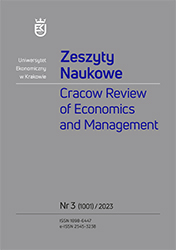Regional Wage Differentiation and Qualitative Determinants of Economic Development: Evidence from Poland
DOI:
https://doi.org/10.15678/ZNUEK.2023.1001.0303Keywords:
wage differentiation, grouping of Polish voivodeships, wage differentiation between poviats, wage determinantsAbstract
Objective: The article shows the differences in salaries in Polish voivodeships and between poviats of individual voivodeships. It also identifies factors, particularly qualitative development ones, which affect them.
Research Design & Methods: Ranking, spread indices, coefficients of variation, and grouping methods were used. Parameters of panel econometric models with random effects and fixed effects were also estimated.
Findings: In the years 2010–2020, wage variation between voivodeships decreased slightly. This indicates a weak process of sigma convergence, but the data about average annual wage growth do not show a clear tendency to beta convergence. The highest average wages were found in Mazowieckie, Śląskie and Dolnośląskie voivodeships, and the lowest in Warmińsko-mazurskie, Podkarpackie, Lubuskie, Kujawsko-pomorskie and Świętokrzyskie. The econometric analysis confirmed that the following factors had a positive impact on wage levels: labour productivity, the share of people with higher education, the number of patents and the share of innovative enterprises, and a negative impact of the unemployment rate. The 2020 pandemic also had a significant positive impact on wages in voivodeships.
Implications / Recommendations: The analyses confirm a significant impact of qualitative development factors on wages in voivodeships.
Contribution: The research complements the Polish literature on the impact of qualitative development factors on regional differences in wages and confirms the validity of using panel models for this type of analysis.
References
Acemoglu D., Angrist J. (1999), How Large Are the Social Returns to Education? Evidence from Compulsary Schooling Laws, NBER Working Paper no. 7444, National Bureau of Economic Research, https://doi.org/10.3386/w7444.
Adamczyk A., Tokarski T., Włodarczyk R. W. (2009), Przestrzenne zróżnicowanie płac w Polsce, “Gospodarka Narodowa”, no. 9(234), https://doi.org/10.33119/GN/101248.
Becker G. S. (1962), Investment in Human Capital: A Theoretical Analysis, “Journal of Political Economy”, vol. 70(5), https://doi.org/10.1086/258724.
Card D. (1999), The Causal Effect of Education on Earnings (in:) Handbook of Labor Economics, vol. 3, O. Ashenfelter, D. Card (eds), Elsevier Science, Amsterdam–New York.
Combes P. P., Duranton G., Gobillon L. (2008), Spatial Wage Disparities: Sorting Matters!, “Journal of Urban Economics”, vol. 63(2), https://doi.org/10.1016/j.jue.2007.04.004.
Dykas P., Misiak T. (2014), Determinanty podstawowych zmiennych rynku pracy w polskich powiatach w latach 2002–2011, “Gospodarka Narodowa”, no. 6(274), https://doi.org/10.33119/GN/100881.
Groot S. P. T., Groot H. L. F. de, Smit M. J. (2014), Regional Wage Differences in the Netherlands: Micro Evidence on Agglomeration Externalities, “Journal of Regional Science”, vol. 54(3), https://doi.org/10.1111/jors.12070.
Harmon C., Oosterbeek H., Walker I. (2000), The Returns to Education: A Review of Evidence, Issues and Deficiencies in the Literature, Centre for the Economics of Education, London.
Lipsey R. G. (1960), The Relation between Unemployment and the Rate of Change of Money Wage Rates in the United Kingdom, 1862–1957: A Further Analysis, “Economica”, vol. 27(105), https://doi.org/10.2307/2551424.
Magda I., Rycx F., Tojerow I., Valsamis D. (2011), Wage Differentials across Sectors in Europe, “Economics of Transition”, vol. 19(4), https://doi.org/10.1111/j.1468-0351.2011.00417.x.
Marshall A. (1890), Principles of Economics, Macmillan, London.
Mincer J. (1958), Investment in Human Capital and Personal Income Distribution, “Journal of Political Economy”, vol. 66(4), https://doi.org/10.1086/258055.
Mincer J. (1974), Schooling, Experience, and Earnings, NBER, New York.
Myck M., Nicinska A., Morawski L. (2009), Count Your Hours: Returns to Education in Poland, IZA Discussion Paper no. 4332, Institute for the Study of Labour, https://doi.org/10.2139/ssrn.1442647.
Newell A., Socha M. (2005), The Distribution of Wages in Poland, 1992–2002, IZA Discussion Paper no. 1485, https://doi.org/10.2139/ssrn.670152.
Pianta M., Tancioni M. (2008), Innovations, Wages, and Profits, “Journal of Post Keynesian Economics”, vol. 31(1), https://doi.org/10.2753/PKE0160-3477310105.
Pigou A. C. (1933), The Theory of Unemployment, Macmillan, London.
Rogut A., Tokarski T. (2007), Determinanty regionalnego zróżnicowania płac w Polsce, “Ekonomista”, no. 1.
Rokicki B. (2013), Ewolucja regionalnego zróżnicowania płac realnych w Polsce, “Gospodarka Narodowa”, no. 9(265), https://doi.org/10.33119/gn/100942.
Schultz T. (1961), Investment in Human Capital, “American Economic Review”, vol. 51(1).
Strawiński P. (2006), Zwrot z inwestowania w wyższe wykształcenie, “Ekonomista”, no. 6.
Strawiński P. (2008), Opłacalność studiów w Polsce. Model i jego wyniki, “Ekonomista”, no. 4.
Strawiński P., Majchrowska A., Broniatowska P. (2018), Wage Returns to Different Education Levels. Evidence from Poland, “Ekonomista”, no. 1.
Tokarski T. (2012), Przestrzenne zróżnicowanie płac w polskich powiatach, “Studia Prawno-Ekonomiczne”, vol. 85.
Wesołowska M. (2018), Przestrzenne zróżnicowanie płac w polskich województwach w latach 1999–2015, “Studia i Prace WNEiZ US”, no. 52(3).
Willis R. J. (1986), Wage Determinants: A Survey and Interpretation of Human Capital Earnings Functions (in:) Handbook of Labor Economics, vol. 1, O. C. Ashenfelter, R. Layard (eds), North-Holland, Amsterdam.
Wysokińska Z. (2001), Konkurencyjność w międzynarodowym i globalnym handlu technologiami, Wydawnictwo Naukowe PWN, Warszawa.
Zieliński K. (2011), Regionalne zróżnicowanie płac w Polsce – kierunki zmian, “Zeszyty Naukowe Uniwersytetu Ekonomicznego w Krakowie”, no. 863.
Downloads
Published
Issue
Section
License
Copyright (c) 2024 Zeszyty Naukowe Uniwersytetu Ekonomicznego w Krakowie / Cracow Review of Economics and Management

This work is licensed under a Creative Commons Attribution 4.0 International License.




